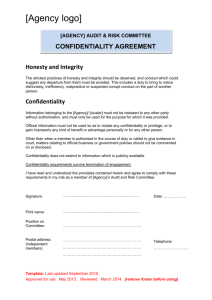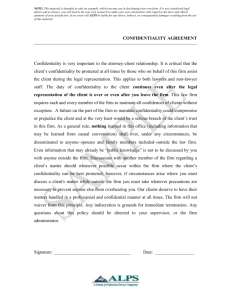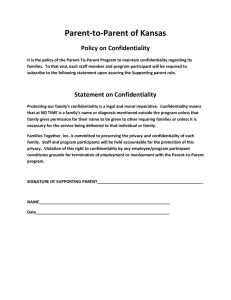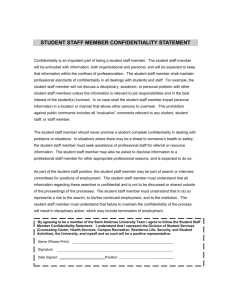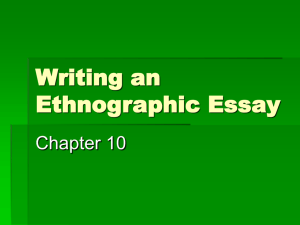Transferring Insights from the Ethnographic Study of Organizational Conflict Management
advertisement
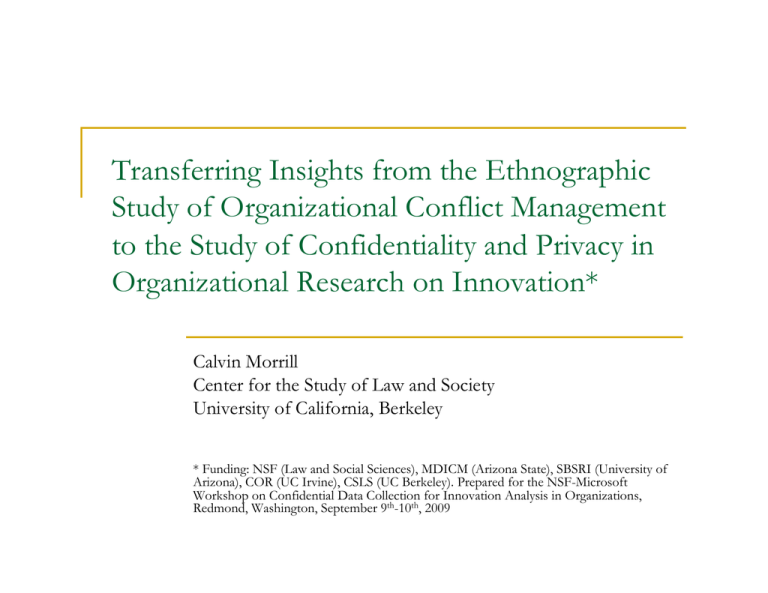
Transferring Insights from the Ethnographic Study of Organizational Conflict Management to the Study of Confidentiality and Privacy in Organizational Research on Innovation* Calvin Morrill Center for the Study of Law and Society University of California, Berkeley * Funding: NSF (Law and Social Sciences), MDICM (Arizona State), SBSRI (University of Arizona), COR (UC Irvine), CSLS (UC Berkeley). Prepared for the NSF-Microsoft Workshop on Confidential Data Collection for Innovation Analysis in Organizations, Redmond, Washington, September 9th-10th, 2009 Four Questions What is ethnography? Why use ethnography to study organizations? Example: conflict management among corporate executives Example: conflict management among high school students What challenges does contemporary ethnography pose for confidentiality? Beginning to think about how to “unpack” confidentiality and privacy in research on innovation What is Ethnography? (Emerson, Fretz, and Shaw 1995; Morrill and Fine 1997) Sustained, systematic observation of and interaction with people as they go about their everyday lives Long-term immersion in other people’s lives Participant observation Writing of fieldnotes (paraphrasing social interaction and discourse) Auxiliary techniques and data Semi-structured and conversational interviews transcripts and fieldnotes Story-based approaches member stories Beyond text: visual data diagrams, maps, photos, videos (researcher- and participant-generated) Mixing qualitative and quantitative methods Why Use Ethnography to Study Organizations? (Morrill and Fine 1997; Fine, Morrill, and Surianarain 2009) Provides: Rich, contextualized descriptions Insight into how organizational members make sense of their organizations and their work (meaning) Portraits of organizations as on-going concerns – the “doing” of organizational work (process and mechanisms) and its connection to outcomes (how and what questions) Gets at social processes difficult to study via other methods But, entails tradeoffs in: Enumerative generalizability vs. theory generation/extension Control Example: Studying How High-Level Managers Handle Conflict How do corporate executives define and manage intraorganizational conflict? Comparative design Interpretive and contingency organization theory Anthropological and sociological theories of disputing/warfare Multiyear PO in 13 corporations 227 in-depth executive interviews Social network analysis Document collection Central findings: Routine conflict management reproduces the normative parameters of proximate organizational contexts (U. Chicago Press, 1995) How Does Organizational Context Influence Executive Conflict Management? Learning social pragmatics “When I first came here, I quickly learned there were certain ways you had to treat your colleagues…certain things you could and shouldn’t do…and there were certain ways for dealing with colleagues when you got into a beef. You didn’t want to win or lose a conflict the wrong way.” [white male vice president] Conflict management and identity “Look, Cal, you have to handle your conflicts with colleagues in the usual way. If you don’t, that can mark you as incompetent. It’s more than that. After a while, handling conflict in particular ways cuts to the bone. It’s who we are. It’s who I am. [white female senior vice president] Implications for innovation and confidentiality Little innovation in routine conflict management Multisite ethnographic studies facilitate masking w/o compromising quality/richness Example: Studying Conflict Handling Among Youth (Morrill et al 2000; Morrill and Musheno forthcoming) Decade-long team fieldwork study of youth in a lower-income, multiethnic high school (case study) Key findings: How do youth make sense of and manage peer conflict in school? Researcher-generated data: ethnographic field-notes, interviews, focus groups Participant-generated data: conflict stories, social maps, photographic essays (difficulty of adults accessing youth “worlds”) Institutional-generated data: police call data, school-level demographics and achievement Youth sophisticated about peer handle most non-violently Context matters: student mobility between frontstages (public audiences) and backstages enables “cooling off,” multiple normative orders Policies and politics (“safe schools” and “zero tolerance” movements) that limit student stages and mobility produces more violence Implications for innovation and confidentiality Studying movements and innovations that produce unanticipated consequences may expand our vocabulary of outcomes Studying protected populations leads to multiple, precarious approaches to confidentiality: masking for researcher-generated data w/ limited transparency for participant-generated data (photographic essays) “La Banda de las Escaleras” (backstage) The Band/Gang of the Stairs I took this picture because I had to finish the film. But I called it La Banda de las Escaleras because a Banda is composed by a group of people. This picture shows la Banda having a conversation. Like when a Banda is practicing to perform. Victoria Gonzalez* 12th grader (1999) * Participant in public on-line gallery. Youth Social Map (1998) “Quad” + Front-stages Anglo Female 11th grader Back-stages “La Banda” Cumulative Social Map of Crossroads High School (1998) * Relational Groups** “La Banda” Latinos Rockaway Blvd. African Americans Whites ** Relational groups identified as “friends,” engaged in joint activities, and/or as “mixed” or racially “diverse”. “Quad” Crossroads Ave. * Source: Youth (9th, 11th, and 12th grade) social maps (n = 181) of Crossroads campus. What Challenges Does Contemporary Ethnography Pose for Confidentiality and Privacy? Richness of ethnographic data can compromise anonymity of organizations, members, and processes Digitization Data access, “ownership,” and “leaks” The meanings of “informed consent” in ethnographic research Qualitative software analysis programs enhance retrieval and linkages to raw data, hence the possibility of identification of those studied Team Fieldwork “Quasi-confidentiality” Blurred boundaries between “researchers” and “organizational members” Calls for greater transparency in qualitative methods means more details must be marshaled about data collection and field sites Can create ”communication dilemmas” (Bonacich 1990) Controversy among ethnographers regarding making fieldnotes accessible to other researchers in data archives Beginning to Think About How to “Unpack” Confidentiality and Privacy in Research on Innovation What do we know? How are normative understandings of confidentiality and privacy negotiated/ bridged in projects involving multiple research communities, private and/or public organizations, and contexts? Work on research ethics/human subjects (e.g., Smith-Doerr 2008,2009) Work on the dynamics of IP (e.g., Kapzynski 2008) Web-based and person-based surveys of popular preferences/practices Legal and philosophical work (e.g., Nissenbaum 2004, forthcoming) Confidentiality and privacy as multiple, potentially contested normative orders law on the books vs. law in action/“legal consciousness” (Silbey 2005) Dispute management and rights consciousness Social power asymmetries May provide empirical insight for forming policy Potential methodological approaches: Participant observation mixed w/ story collection (framing) Surveys of research communities on orientations toward confidentiality and privacy, and dispute management

